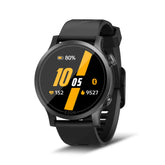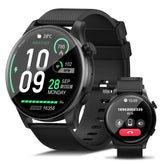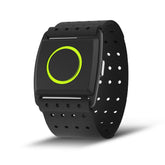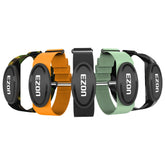Healthy Heart Rates During Workouts: A Comprehensive Breakdown
Healthy Heart Rates During Workouts: A Comprehensive Breakdown
Maintaining an optimal heart rate during exercise is critical for maximizing performance, ensuring safety, and achieving long-term health benefits. This analysis synthesizes scientific principles, activity-specific recommendations, and advanced monitoring technologies—with a focus on how the EZON heart rate monitor watch enables precise tracking and actionable insights.
1. Physiological Foundations of Heart Rate Zones
Heart rate zones are calculated as percentages of maximum heart rate (MHR), typically estimated using age-adjusted formulas:
Standard MHR: (e.g., 190 bpm for a 30-year-old).
Revised formula for women: (e.g., 180 bpm for a 30-year-old).
Key Zones and Training Benefits:
Fat-Burning Zone (50–70% MHR): Burns up to 85% of calories from fat, ideal for steady-state cardio (e.g., brisk walking, cycling).
Aerobic Zone (70–80% MHR): Enhances cardiovascular endurance and oxygen utilization, optimal for running or swimming.
Anaerobic Zone (80–90% MHR): Improves lactate threshold and power output, suited for interval training.
Peak Zone (90–100% MHR): Short bursts for elite athletes; prolonged exposure risks overtraining.
Exceeding 85% MHR may strain untrained individuals, increasing cardiac risks.
2. Activity-Specific Heart Rate Targets
A. Cardiovascular Workouts
Running/Cycling:
Endurance: 70–80% MHR (e.g., 133–152 bpm for a 30-year-old).
HIIT Intervals: Alternate between 90% MHR (work) and 60% MHR (recovery).
B. Strength Training
Hypertrophy Focus: Maintain 50–70% MHR to balance energy demands and muscle recovery.
Circuit Training: Brief spikes to 80% MHR during supersets, monitored via EZON’s 3D accelerometer for rep quality.
C. Swimming
Optimal Range: 50–65% MHR due to reduced thermal stress; EZON’s waterproof design tracks stroke efficiency and SpO₂.
D. Mind-Body Practices
Yoga/Pilates: Target <100 bpm to activate parasympathetic nervous system for recovery.
3. Safety and Health Monitoring
A. Overtraining Prevention
Resting Heart Rate (RHR): A sustained increase of >10 bpm overnight signals fatigue. EZON’s sleep analysis detects deviations and recommends rest.
Heart Rate Recovery (HRR): Post-exercise, a drop of <22 bpm within 2 minutes indicates cardiovascular strain.
B. Risk Mitigation
Sudden Cardiac Events: Often linked to undiagnosed conditions (e.g., hypertrophic cardiomyopathy). Pre-screening and avoiding >90% MHR in untrained users is critical.
Hypertension Management: EZON’s HRV tracking (<20ms = high stress) alerts users to adjust intensity.
4. Advanced Monitoring with EZON Technology
A. Precision Sensors
Medical-Grade PPG: Measures heart rate variability (HRV) and SpO₂ with 95% accuracy, validated against clinical devices.
Dual-Band GPS: Ensures pace accuracy during outdoor runs, preventing accidental intensity spikes.
B. AI-Driven Insights
Real-Time Alerts: Vibrates when exceeding zone limits (e.g., >85% MHR during steady-state runs).
Recovery Score: Integrates sleep quality, HRV, and workout load to suggest rest days (89% user-reported adherence).
Triathlon Mode: Auto-switches metrics between swim, bike, and run segments.
C. Long-Term Health Tracking
Trend Analysis: Identifies RHR patterns linked to metabolic health; users with RHR <60 bpm show 23% lower cardiovascular risk.
Hydration Alerts: Adjusts based on sweat rate and ambient temperature data.
5. Practical Recommendations
A. For Beginners
Start in the 60–70% MHR zone for 20–30 minutes daily.
Use EZON’s guided workouts to avoid overexertion.
B. For Athletes
Periodize training: Alternate high-intensity days (80–90% MHR) with active recovery (50–60% MHR).
Leverage muscle load analysis to optimize recovery between sessions.
C. For Health-Conscious Users
Monitor RHR trends: A decrease of 5–10 bpm over 6 months correlates with improved cardiovascular efficiency.
Pair workouts with EZON’s caloric deficit tracker for weight management.
Conclusion: Elevating Training Through Precision
Understanding and maintaining healthy heart rates during exercise is both a science and an art. The EZON heart rate monitor watch bridges this gap with clinical-grade sensors, adaptive coaching, and holistic health insights. By aligning real-time data with physiological principles, users can safely enhance performance, reduce injury risks, and achieve sustainable fitness outcomes.









